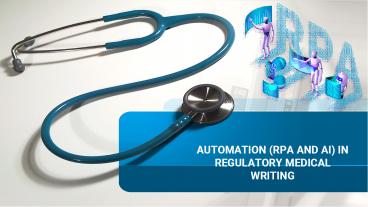AUTOMATION IN REGULATORY MEDICAL WRITING - PowerPoint PPT Presentation
Title:
AUTOMATION IN REGULATORY MEDICAL WRITING
Description:
Writing a regulatory document is a difficult and time-consuming task. It is because of the presence of a large amount of data and strictly following the regulatory guidelines. Robotic process automation and artificial intelligence help in easing the load on regulatory medical writers. – PowerPoint PPT presentation
Number of Views:37
Title: AUTOMATION IN REGULATORY MEDICAL WRITING
1
AUTOMATION (RPA AND AI) IN REGULATORY MEDICAL
WRITING
2
INTRODUCTION
Writing a regulatory document is a difficult and
time-consuming task. It is because of the
presence of a large amount of data and strictly
following the regulatory guidelines. Robotic
process automation and artificial intelligence
help in easing the load on regulatory medical
writers.
3
REGULATORY MEDICAL WRITING
Regulatory medical writers help the
pharmaceutical, biotechnology, and medical device
organization to apply for the approval of medical
drugs and devices. The regulatory writers are
experts in understanding the procedures, formats,
and guidelines of respective drug and medical
device regulatory authorities. Further, the
regulatory writer also helps filing several
documents, such as post-marketing surveillance or
pharmacovigilance obligations after the approval.
4
Contd..
The regulatory medical writers are employed by
the pharmaceutical companies and several clinical
research organizations that help them to develop
complex regulatory documents. The regulatory
documents may include the protocols, synopsis,
rationale and justification, and other
manufacturing-related details.
5
CHALLENGES IN REGULATORY MEDICAL WRITING
Regulatory medical writing has several
challenges. Some of the challenges are inherent
to the regulatory domain, while the other
challenges are commonly present in almost all
fields of medical writing. Some of the challenges
of regulatory medical writing are
6
Contd..
- More complex and time-consuming As compared to
other medical writing domains, like medical
communication and medical branding, regulatory
medical writing is more complex and required an
in-depth understanding of the formulation under
consideration. - Time-restriction Although all medical documents
have time limitations, the consequences of
lapsing the final date in filing the regulatory
document are serious. Structured The challenges
in writing the regulatory documents are that they
are more structured, and it is necessary all the
time to maintain consistency - Accuracy and consistency The content should be
accurate, consistent, and without any ambiguity.
Failing this may result in document rejection.
7
ROBOTIC PROCESS AUTOMATION IN REGULATORY WRITING
There are complexities in the drug regulatory
environment. Increased document strictness,
frequently changing the guidelines, the addition
of new requirements, and the incorporation of
additional data requirements result in the
demands for more advanced technological
solutions. Robotic process automation is one such
solution that may help in managing the drug
regulatory complexity. It offers several
advantages to the people working in drug
regulatory departments. There are several types
of robotic process automation.
8
Contd..
Regulatory Process Automation also helps in
checking the documents that are to be submitted
for regulatory approval. The automated process
may help in checking the setting and the
bookmarks. It also helps in arranging a lot of
data that is coming from the clinical research
organizations in case of approval of a drug that
requires clinical trials.
9
ARTIFICIAL INTELLIGENCE IN REGULATORY WRITING
Artificial intelligence significantly changed the
regulatory writing domain. The number of
regulatory filings is increasing and simultaneous
clinical trials of several drugs are under
process. It will result in the generation of a
lot of complex data. Artificial intelligence
developed specifically for regulatory affairs
helps in providing the updated regulatory
requirements from several regulatory authorities,
such as USFDA, UK-MHRA, TGA, and Health Canada.
10
Contd..
Artificial intelligence also helps in managing
the drug development process and ensuring that
everything is streamlined as per the requirements
of the regulatory authority. Data mining and data
analysis are the other functions performed by
artificial intelligence in regulatory affairs.
11
Contact Us
Email - info_at_smiqgen.com Mobile - 91
7305339402 Website - https//www.smiqgen.com/































